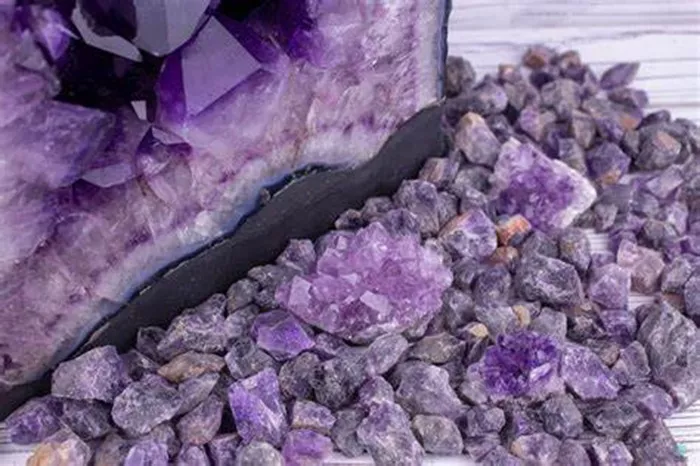Amethyst, renowned for its captivating purple hues, is a variety of quartz that has fascinated gem enthusiasts and geologists alike. This precious gemstone has a rich history and is used in various forms of jewelry and ornamental pieces. To fully appreciate its beauty and value, it is crucial to understand the geological context in which amethyst is found. This article explores the types of rocks and geological environments where amethyst can be discovered, providing a comprehensive overview for anyone interested in this stunning gemstone.
Geological Background of Amethyst
Amethyst is a crystalline form of quartz that owes its violet color to the presence of iron and the influence of natural irradiation. Quartz is one of the most abundant minerals on Earth, forming in a variety of geological environments. Amethyst’s specific color and formation are unique to certain conditions, making its discovery both interesting and varied.
Types of Rocks Containing Amethyst
Amethyst can be found in several types of rocks, each contributing to the unique characteristics of the gemstone. The primary rock types associated with amethyst deposits are:
Volcanic Rocks
Volcanic rocks, particularly those that form from the cooling of lava, are one of the most common hosts for amethyst. These rocks, known as basalt and rhyolite, provide a favorable environment for the formation of amethyst geodes and crystals. The volcanic rocks create cavities where mineral-rich solutions can precipitate and form amethyst crystals.
Basalt
Basalt is a dark-colored volcanic rock that forms from the rapid cooling of basaltic lava. It is often rich in iron and magnesium, elements that can contribute to the formation of amethyst. Amethyst is typically found in the cavities or vesicles within basalt flows. These cavities are filled with mineral-rich solutions that eventually crystallize into amethyst.
Rhyolite
Rhyolite is another volcanic rock that can host amethyst. It forms from the rapid cooling of high-silica lava and often contains a variety of mineral inclusions. Amethyst found in rhyolite is usually in the form of small crystals within volcanic cavities or as part of a larger mineral assemblage.
Sedimentary Rocks
While less common than volcanic hosts, sedimentary rocks can also contain amethyst. These rocks form from the accumulation of sediment and can include sandstones, shales, and limestones. Amethyst found in sedimentary rocks is often associated with secondary mineral deposits that have been transported and redeposited from primary sources.
Sandstone
Sandstone, composed of sand-sized mineral grains, can host amethyst crystals, especially in regions where ancient volcanic activity has transported quartz crystals into sedimentary layers. The amethyst crystals found in sandstone are usually smaller and less well-formed compared to those in volcanic rocks.
Limestone
Limestone, formed primarily from calcium carbonate, can contain amethyst in the form of secondary mineral deposits. The amethyst crystals may occur in pockets or veins within the limestone, often associated with other mineral deposits.
Pegmatites
Pegmatites are coarse-grained igneous rocks that form from the crystallization of magma. They are known for their large crystal sizes and can host a variety of gemstones, including amethyst. Pegmatites provide a unique environment where amethyst crystals can grow to impressive sizes.
Granite Pegmatites
Granite pegmatites are rich in quartz and feldspar and are known for containing large amethyst crystals. The slow cooling of the magma allows for the formation of sizable crystals, including amethyst, which can be found in pockets or cavities within the pegmatite.
Albite Pegmatites
Albite pegmatites, which are rich in sodium feldspar, can also host amethyst. The presence of amethyst in these pegmatites is less common but still notable. The crystals found in albite pegmatites can vary in size and quality.
See also: What Should You Avoid with Amethyst?
Geological Environments Favorable for Amethyst Formation
Amethyst forms in specific geological environments where the conditions are right for its crystallization. These environments include:
Hydrothermal Vents
Hydrothermal vents are locations where hot, mineral-rich water is expelled from the Earth’s crust. These vents often create a favorable environment for the deposition of amethyst and other minerals. The mineral solutions that emerge from hydrothermal vents can deposit amethyst crystals in cavities and geodes.
Geodes
Geodes are hollow rock formations filled with mineral deposits. Amethyst geodes form when gas bubbles or cavities within volcanic rocks are filled with mineral-rich solutions. Over time, the solutions crystallize into beautiful amethyst clusters.
Mineral Deposits
Amethyst can also be found in mineral deposits that have formed from the erosion of volcanic rocks. These deposits are often found in riverbeds, alluvial plains, or sedimentary layers where the amethyst crystals have been transported from their original volcanic source.
How Amethyst Crystals Form
The formation of amethyst crystals involves several geological processes:
Mineral Solutions
Amethyst crystals begin to form when mineral-rich solutions fill cavities or geodes within rocks. The primary minerals involved in the formation of amethyst include quartz, iron, and trace elements that influence the color.
Crystallization
As the mineral solutions cool and evaporate, quartz crystals begin to form. The presence of iron and natural irradiation gives the crystals their distinctive violet color. The crystals continue to grow until the cavity or geode is filled.
Erosion and Transport
Once formed, amethyst crystals can be exposed to erosion and transport processes. These processes can move the crystals from their original location and deposit them in sedimentary layers or riverbeds.
Conclusion
Amethyst is a fascinating gemstone found in a variety of geological environments and rock types. Its presence in volcanic rocks, sedimentary formations, and pegmatites highlights the diverse conditions required for its formation.
Understanding the types of rocks that host amethyst provides valuable insight into the geological processes that create this beautiful gemstone. Whether found in geodes, sedimentary layers, or as part of a pegmatite, amethyst continues to captivate gem enthusiasts and geologists alike with its stunning purple hues and intricate crystal formations.

